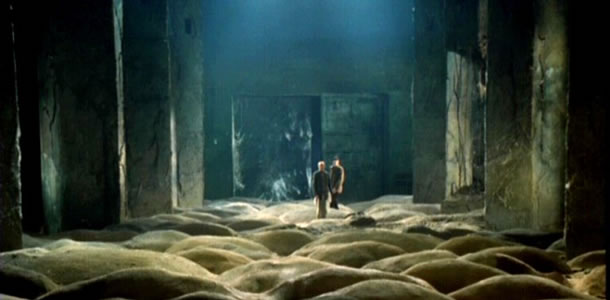“Stalker”: Andrei Tarkovsky, Faith and the Soviet Union
Early in “Stalker,” Andrei Tarkovsky’s newly re-released 1979 futurescape, a character known only as The Writer (Anatoly Solonitsyn) recaps the virtues of the Middle Ages. Unlike modern times with their defeating way of explaining everything, centuries past were flavored by the prevalence of mystery. Every house had its own goblin.
In the film’s dreary Soviet house the goblin has a name, Monkey, a brave little blondie unable to walk because of lame legs. At the film’s famous conclusion she appears to push glasses across a table with her mind. Is she telekinetic? Has a miracle happened? The glasses shake again. The faint call of a coming train grows to a full rumble. The glasses jolt, once more, around the table.
Throughout “Stalker,” things happen twice. They are first explained by mystical power. Then they are explained again by material reality. We are forced to choose between the miraculous and the mundane.
The events of “Stalker” take place in an uninhabited, polluted thicket known as The Zone. Something happened there, maybe 2 years ago, maybe 20, but no one knows quite what. Authorities claim a meteorite crashed. Thousands died. Cars turned to ash. Survivors slowly disappeared. Years passed. The whispers came to say the origin was an alien, or even supernatural. In a secret part of The Zone, it came to be understood, stands The Room – a cement bunker rumored to make a person’s deepest wishes come true.
To find The Room safely, a pilgrim needs a “Stalker” (Alexander Kaidonowsky), a guide that knows The Zone’s ever-shifting landscape. No path there is ever the same. Whatever force lies at the center of The Zone might decide it doesn’t like you. Without a guide, you might not make it out alive.
The one we follow sees each trip as a spiritual mission. As a one-time convict, he treasures the chance to lead the despairing to a fountain of happiness. With time, however, his visitors have started to sicken him with their cynicism and doubt. Each trip inside has become a test of his faith.
“Stalker” has the weird distinction of growing out of two apocalyptic events in Russia’s generally apocalyptic history. This is made even weirder by the fact that one of them hadn’t happened yet at the time of filming. The first is Tunguska, the 1908 incident in Siberia where a meteorite is thought to have explosively crashed in the middle of nowhere. The second is its clairvoyance about the 1986 Chernobyl disaster, a disaster that didn’t happen until seven years after the film’s release. Each one has a rational scientific explanation. And each one has attracted theories of more mysterious origins.
Planted firmly in the information control in the Soviet Union, Tarkovsky is identifying a cycle of truth, myth, faith and authoritarian power. The people are unable to explain the world around them because of the shortage of information. So they begin to invent their own reality. This interplay between imagination and consciousness, particularly when informed by faith or superstition, long has been at the top of Tarkovsky’s concerns.
As “Stalker” switches between sepia and modern film stock, the camera takes lazy-hazy observational cinema to extremes. Instead of having the camera slavishly follow the characters, often the camera stares at something in the room and the characters circle around it. They enter and leave the frame at different points in long, calm shots. One person will walk out of a frame, with the camera floating slowly through a building or meadow. Then the person will reappear, without a cut, doing something else. This technique produces a slow, ghostly feeling. However, editing in Russian cinema sometimes is a political gesture as much as a textual one. Long takes, like in Sokurov’s Russian Ark, are sometimes rejections of Eisenstein’s Bolshevik legacy of montage. And I wonder if that is the goal here.
I first watched “Stalker” twenty years ago as a college student. It seemed like a movie from way past the moon. Watching it now, with a better intellectual palette and more experience with Tarkovsky, I get the opposite sense. Intellectually, it’s dense. But the storytelling generously shares its secrets, almost to the point of being over-determined. Gone is the sort of evasiveness that runs through, for instance, Tarkovsky’s “Zerkalo” (“Mirror”). “Stalker” has the feeling of an artist a little sick of being at the center of a “what does it mean?” mystery and wants to be understood.
news via inbox
Nulla turp dis cursus. Integer liberos euismod pretium faucibua




